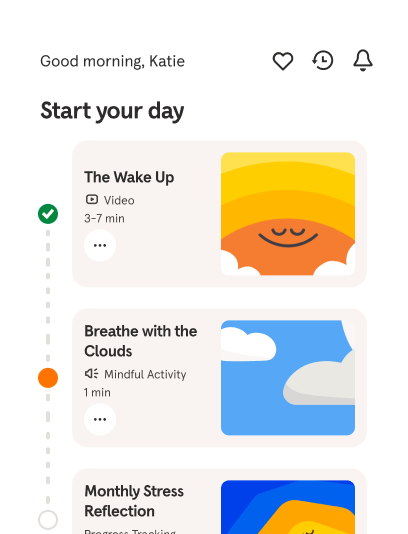Breathwork Basics
Dora introduces how to use the breath intentionally, and the impact it has on your well-being.
Try 14 days freeBetter mental health starts with Headspace. Unrivaled expertise to make life feel a little easier, using guided meditations, mindfulness tips, focus tools, sleep support, and dedicated programs.
Try 14 days free
(soft music) Hi everyone. My name is Dora. And I'm one of the meditation teachers here at Headspace. Today, we're talking about all things breathwork, and how breathwork has made such a huge impact on my overall wellbeing, and my meditation practice. So similar to meditation, there's many types of breathwork techniques and practices, and it's been around for many years. There's breathing exercises for relaxation, for calm increased levels of energy, and much more. I was first introduced to breathwork about four years ago. However, I was introduced to the more therapeutic forms of breathwork, like holotropic breathwork, and the conscious connected breath. And these breathwork practices aim to release, or bring to surface, emotions and energies that can get stuck in the body. The first session that I did, I fell in love. I think it was because the shift that happens within the mind, and body, happens so quickly. And it's also so empowering to know that you have this superpower, which is your breath, that can help you feel so connected, and at peace. Over the years, I've learned about the different types of breathing techniques. And I even went on to get my certification in breathwork, so I could guide others in my community. For now will focus on beginner breathwork techniques and a few of my favorite ways that you can begin to incorporate these techniques into your meditation practice, or everyday life. I like to begin each sitting meditation practice with a few rounds of deep breathing, or alternate nostril breathing. And I find this helps calming my mind, and grounding myself into the present moment. Something else that I've found is that deep breathing can really help us to get out of our heads, and be fully present in our bodies. Outside of meditation, I'll often use breathwork if I'm doing anything that makes me feel nervous or anxious, like giving a speech, doing a presentation, sitting for an interview, even before, during, after a difficult conversation. I'll practice deep breathing, box breathing, or simply slowing down my exhales, as a way to ground and reenter. But to be honest, I practice breathwork all the time, because it's just so accessible. Like even right now, you can do it anywhere. I highly recommend that you take your time to try out the different practices, and see what techniques and exercises resonate with you the most. While breathwork does have its benefits, it can also be quite activating in the body. And it may even cause some discomfort. So it's important to keep that in mind, that my instructions are more of an invitation, and you have the choice, at any time, to let go of my guidance, pause the technique, and shift your focus to something else that can help to settle the body. This can be done by bringing the focus to an object in your environment, noticing your hands, or even just gently stretching the body....
Details
About your teachers
 Andy PuddicomeHeadspace Co-founderMore about Andy
Andy PuddicomeHeadspace Co-founderMore about AndyA former Buddhist monk, Andy has guided people in meditation and mindfulness for 20 years. In his mission to make these practices accessible to all, he co-created the Headspace app in 2010.
 Eve Lewis PrietoHeadspace Director of MeditationMore about Eve
Eve Lewis PrietoHeadspace Director of MeditationMore about EveEve is a mindfulness teacher, overseeing Headspace’s meditation curriculum. She is passionate about sharing meditation to help others feel less stressed and experience more compassion in their lives.
 Dora KamauMeditation TeacherMore about Dora
Dora KamauMeditation TeacherMore about DoraAs a meditation teacher, Dora encourages others to live, breathe, and be with the fullness of their experiences. She loves meditation’s power to create community and bring clarity to people’s minds.
 Kessonga GiscombeMeditation TeacherMore about Kessonga
Kessonga GiscombeMeditation TeacherMore about KessongaKessonga has been an acupuncturists, therapist, and meditation teacher, working to bring mindfulness to the diverse populations of the world.
 Rosie AcostaMeditation TeacherMore about Rosie
Rosie AcostaMeditation TeacherMore about RosieRosie Acosta has studied yoga and mindfulness for more than 20 years and taught for over a decade. Rosie’s mission is to help others overcome adversity and experience radical love.

Your lifelong guide to better mental health
Stress, sleep, and all the challenging emotions — care for your mind with the everyday mental health app that's shown to make a difference.
Try 14 days free
Look after your mind
Proven guided meditations and programs to help you stress less, sleep more soundly, and better navigate life’s challenges

Science-backed
Studies show that using Headspace for 30 days can reduce stress, increase resilience, and improve overall well-being

Explore 1000+ expert-led exercises
Access our library of meditations, breathing exercises, and guidance videos for stress, sleep, focus, everyday anxiety , parenting, and more.




Members are enjoying happier and healthier lives
Frequently asked questions
- How to breathe during meditation
No special meditation breathing techniques are required in a standard meditation. You simply breathe normally throughout, except when first starting the exercise — that’s when the teacher usually invites you to take some long, deep, audible breaths to settle in, allowing the body to feel the calming effect of those deliberate inhales and exhales. But after that, it becomes a standard guided breathing meditation where your object of focus will be your natural rhythm of breathing. In fact, your breath is where you place your attention, each time the mind wanders. A thought drifts in, you let it go, and return to your focus on the breath. We also offer the “Breathe Through Tension” meditation which is designed to help you release stress or tension.
- How to do meditation breathing techniques
A calming meditation and a more structured breathwork meditation can help you combat stress or overcome any jitters. In addition to Breathwork Basics, we offer a choice of meditation breathing techniques, including the five-minute Breathing into Stress. The simplest method is to count your breaths. Start by counting 1 on a slow inhale through the nose, 2 on the long exhale through the mouth, 3 on the inhale, 4 on the exhale, and so on. If you are struggling with racing thoughts that are leaving you feeling on edge, feel free to lengthen each exhale. For example: breathe in for 4 seconds, and breathe out for 6 seconds. Play around with those calming counts so that you feel comfortable.
- What is breathwork meditation?
A breathwork meditation is a calming exercise which involves you consciously taking more intense, controlled breaths. It usually involves deep diaphragmatic breathing (aka belly breathing) as opposed to the chest breathing of a standard, guided breathing meditation. Breathwork and meditation are often combined because they both serve to stimulate the “relaxation response” of the parasympathetic nervous system. There are numerous forms of breathwork, and so it depends on which technique works best for you (and your body and mind).
- What is the difference between meditation and breathwork?
Meditation breathing techniques are not the same as doing breathwork meditation. A standard, calming meditation asks that you do nothing more than observe your natural rhythm of breathing, without manipulating the breath. A breathwork exercise on the other hand asks you to adjust your breathing pattern, whether that involves holding an inhale/exhale for a certain number of seconds, or adopting varying degrees of intensity. Meditation is often a more tranquil experience. Breathwork is often more invigorating. But the common ground they share is the sense of calm experienced as a result of both practices.
- What is breathwork? How does it work?
Breathwork Basics is a video explaining the basics of breathwork filmed by Headspace teacher Dora. Breathwork is different to breathing exercises in meditation because you are learning to use the breath intentionally to impact your sense of well-being and energy levels. Essentially, the purpose of breathwork is to help you surface and release emotions and energy that feel “stuck’ in the body. Using conscious breathing that is often more intense than your natural rhythm, you are shifting those emotions and that energy purposefully. As Dora says, your breath becomes “a superpower”, helping you to feel unstuck and empowered. It can take the form of box breathing, deep breathing, or belly breathing, and it all depends on what breathing technique works best for you.
- © 2025 Headspace Inc.
- Terms & conditions
- Privacy policy
- Consumer Health Data
- Your privacy choices
- CA Privacy Notice


